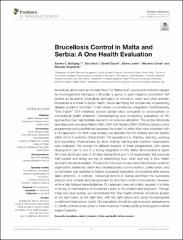Brucellosis Control in Malta and Serbia: A One Health Evaluation

View/
Date
2018Author
Buttigieg, Sandra C
Savić, Sara
Cauchi, Daniel
Lautier, Elaine
Canali, Massimo
Aragrande, Maurizio
Metadata
Show full item recordAbstract
Brucellosis, also known as “undulant fever” or “Malta fever”, is a zoonotic infection caused
by microorganisms belonging to Brucella, a genus of gram-negative coccobacilli that
behave as facultative intracellular pathogens of ruminants, swine and other animals.
Brucellosis is a threat to public health, hence identifying the optimal way of preventing
disease spread is important. Under certain circumstances, integrated, multidisciplinary
“One Health” (OH) initiatives provide added value compared to unidisciplinary or
conventional health initiatives. Conceptualizing and conducting evaluations of OH
approaches may help facilitate decisions on resource allocation. This article historically
describes and comparesMalta’s 1995–1997 with Serbia’s 2004–2006 brucellosis control
programmes and quantitatively assesses the extent to which they were compliant with
a OH approach. For both case studies, we describe the OH initiative and the system
within which it operates. Characteristic OH operations (i.e., thinking, planning, working)
and supporting infrastructures (to allow sharing, learning and systemic organization)
were evaluated. We scored the different aspects of these programmes, with values
ranging from zero to one (1 = strong integration of OH). Malta demonstrated a higher
OH index (0.54) and ratio (1.37) than Serbia (0.49 and 1.14 respectively). We conclude
that context and timing are key to determining how, when and why a One Health
approach should be applied. The adoption of a true OH approach that involved systemic
organization, leadership clarity and transdisciplinary communication, collaboration, and
co-ordination was essential to Malta’s successful eradication of brucellosis after several
failed attempts. In contrast, contextual factors in Serbia permitted the successful
adoption of a primarily sectorial approach for short term control of brucellosis. However,
while a fully-fledged transdisciplinary OH approach was not initially required, it is likely
to be key to maintenance of brucellosis control in the medium and long term. Through
these two case studies, we demonstrate that One Health initiatives should be applied
at the right place, at the right time, with the right people and using the appropriate
conditions/infrastructure. Lastly, OH evaluations should include economic assessments
to identify optimal of resources in these situations, thereby justifying funding and political
support required.
